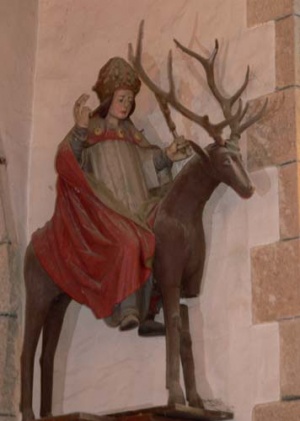Sant Telio
Un article de GrandTerrier.
1 Fiche signalétique
|
2 Almanach
| |||||||||||||||||||||
3 Sources
|
4 Iconographie | |||||||||||||||||||||
5 Monographies
Site Bretagne.net :
Telo - Tella
prénom F/M, fête le 9 février
Déclinaisons du prénom breton : Tilio - Tlio - Téliau - Théliau
Origine du prénom
Les prénoms "Tilio - Tlio - Téliau - Théliau" proviennent de Teilo, nom de l'évêque de Llandaff au VIe siècle, métropole de Cambrie, successeur de saint Dubrice (Dyfrig).
Teilo est un dérivé hypocoristique de Eliud (to-eliud) qui signifie "oint de Dieu". Son orthographe armoricaine a connu beaucoup de variations : on écrira en breton Telo et en français Thélo, Théleau, Téliau, Théliau. Les Gallois conserveront quant à eux l'orthographe unique de Teilo.
Il est le saint Patron de Landeleau, de Leuhan (29), de Saint-Thélo (22) et de Montertelot (56), des villes galloises de Llandaff, Llandeilo, Penalun...
Il est fêté le 9 février dans ses paroisses et patronne chaque année, à la Pentecôte, la célèbre troménie de Landeleau, où ses reliques sont portées en procession tout autour de la paroisse.
Site Catholic.org :
St. Teilo
(Eliud.)
"Archbishop" of Llandaff, born at Eccluis Gunniau, near Tenby, Pembrokeshire; died at Llandilo Vawr, Carmarthenshire, probably in or before 560, an old man, but Ussher puts his death at 604. Sir John Rhys thinks that his true name was Eliau or Eilliau; in Latin it usually appears as Teliarus, in Breton as Teliau, and in French as Télo. He was cousin to St. David and born of a good family settled at Penally, near Tenby. His father, whose name was probably Usyllt, may possibly be identified with St. Issell, the patron of the parish church of Saundersfoot. His sister Anaumed, or Anauved, married King Budic of Armorica, and became the mother of St. Oudaceus, Teilo's successor. The earliest extant biographies of the saint are late and uncritical. Educated under St. Dyfrig or Dubric, at Hentland, Herefordshire, and under St. Paul the Old or Paulinus at Whitland, Carmarthenshire, he subsequently ruled the monastic school at Llandaff, named after him Bangor Deilo. The story of his visit to Palestine with SS. David and Padarn (or Paternus) about 518, and their consecration there as bishops by John III, Patriarch of Jerusalem, is not now generally credited; but it seems that about that date, when St. Dubric withdrew to Bardsey, St. Teilo succeeded him at Llandaff. In 547 the "yellow plague" began to ravage Wales, and shortly afterwards St. Teilo with many of his flock crossed to Armorica, where they were hospitably entertained by his friend St. Sampson, Abbot and Bishop of Dol. After seven years and seven months Teilo returned to Wales, and is said to have been elected to the archiepiscopate vacant by the death of St. David, and to have transferred it from Menevia to Llandaff ; but the more general modern opinion seems to be that in Wales at that epoch the episcopate was not yet diocesan.
The story of the three bodies of the saint, which were discovered the day after his death, was probably invited to account for the fact that the churches at Llandaff, Llandilo Vawr, and Penally, all claimed to possess his body. Doubtless at his death his relics were widely distributed. Today they are venerated at Landeleau (Finistère), Plogonnac (Finistère), and Saint Télo (Côtes-du-Nord). Five parish churches in Brittany are dedicated to him (Landeleau, Leuhan, Montertelot, Plédéliac, and Saint Télo) as well as a chapel between Plogonnac and Locronan. The modern Catholic church at Tenby bears the names of "Holyrood and St. Teilo". The dedication of twelve churches in the present Anglican Diocese of St. David's, and of six in that of Llandaff, show they owe their origin to this zeal. Borlase argues his connection with six dedications in Cornwall and Devon. It is stated that he was formally canonized, but no date is given. He is not infrequently represented in Breton churches as riding on a stag. His festival is, or was, kept in Wales and at Saint Télo on 9 February; at Dol, was a double, on 29 November; and in other places in Brittany on 25 November.
